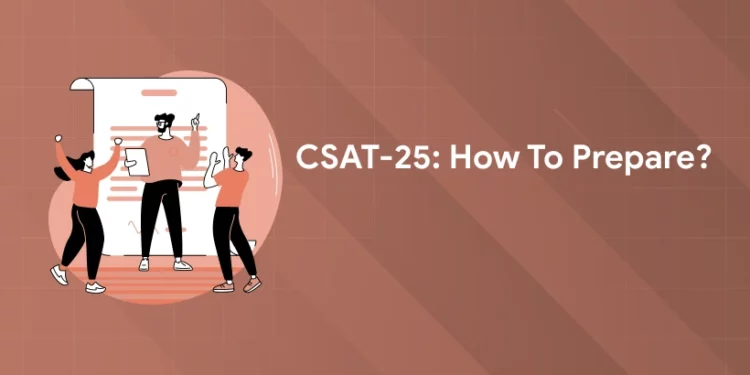Table of Contents
The Civil Services Aptitude Test (CSAT) is an integral part of the UPSC Prelims, and though qualifying in nature, it plays a decisive role in determining whether you advance to the next stage of the examination process. Many aspirants overlook or underestimate CSAT, only to regret it later when they fail to clear this paper. In this blog, we’ll explore how to tackle the UPSC CSAT effectively and mention some resources you can use to improve your preparation, both from Sleepy Classes and outside sources.
5 Tips to Prepare CSAT for UPSC
CSAT tests your logical reasoning, analytical ability, decision-making, and problem-solving skills. It is a qualifying paper, which means you only need to score 33% marks to pass it.
There are many tips and strategies that can help you prepare for CSAT effectively:
- Understand the syllabus and exam pattern: Visit the UPSC website for accurate UPSC CSAT Syllabus. The syllabus covers topics such as comprehension, interpersonal skills, general mental ability, basic numeracy, and data interpretation. The exam pattern consists of 80 questions with a negative marking of 0.83 marks for each wrong answer.
- Prepare a study schedule: Create an organised timetable and dedicate at least one hour of your preparation time for CSAT. Allocate sufficient time for each topic according to your strengths and weaknesses. Revise the topics regularly and practise mock tests.
- Read newspapers daily: Newspapers are a great source of current affairs and general knowledge. They also help you improve your vocabulary and comprehension skills. Read newspapers like The Hindu or The Indian Express daily and make notes of important facts and events.
- Solve previous year papers: Solving UPSC previous year papers will help you familiarise yourself with the type and level of questions asked in CSAT. It will also help you assess your performance and identify your mistakes.
- Join a CSAT Course or Test Series: It has been often observed how UPSC aspirants neglect preparing for CSAT Test till the last minute and eventually end up regretting their decision. Preparing for UPSC CSAT under the expert guidance of a mentor can help you become acquainted with the tips and tricks required to solve CSAT questions with ease. A UPSC CSAT Test Series will help you identify the gaps in your preparation and become more confident about your preparation.
Prepare for Competitive Exams! Download Entri App
Key Areas in UPSC CSAT
1: Which one of the following is not a Harappan site?
The UPSC CSAT comprises several key sections:
- Reading Comprehension: This includes passages followed by questions testing your ability to understand and interpret the text.
- Logical Reasoning and Analytical Ability: These questions test your ability to analyze patterns, sequences, and logical reasoning.
- Quantitative Aptitude: Basic mathematics questions on topics like percentages, profit and loss, time and work, speed, etc.
- Data Interpretation: These questions involve interpreting data from tables, graphs, and charts.
- Decision Making and Problem Solving: These assess your ability to make decisions based on given scenarios.
Why Aspirants Struggle with UPSC CSAT
Despite being qualifying in nature, many aspirants struggle with the UPSC CSAT. This happens because:
- Neglect: Aspirants focus too much on General Studies and think they can “wing it” in CSAT.
- Weakness in Mathematics: Candidates from non-mathematical backgrounds often find the quantitative sections challenging.
- Difficulty in Comprehension: English comprehension passages can be complex, and time management becomes difficult.
- Overconfidence: Many aspirants underestimate the difficulty level, leading to careless mistakes.
How to Tackle UPSC CSAT Effectively
Here are some actionable tips on how to prepare effectively for the UPSC CSAT.
The Civil Services Aptitude Test (CSAT) is a critical component of the UPSC Prelims. While it’s qualifying in nature (requiring 33% or 66 marks out of 200), many candidates face challenges due to its unpredictable nature. Here’s a roadmap to tackle CSAT effectively:
1. Understand the Exam Pattern and Syllabus
- Pattern: CSAT is Paper II of the Prelims, containing 80 questions to be solved in 2 hours. Each question carries 2.5 marks, and there’s a penalty of 1/3rd for incorrect answers.
- Syllabus Highlights:
- Comprehension: Reading passages and answering related questions.
- Logical Reasoning & Analytical Ability: Puzzles, syllogisms, and data analysis.
- Quantitative Aptitude: Basic numeracy, graphs, and arithmetic.
- Decision Making: Questions without negative marking.
2. Evaluate Your Strengths and Weaknesses
- Attempt previous years’ CSAT papers or a mock test to identify strong and weak areas.
- If you’re strong in comprehension and reasoning, focus on those sections. If math is a weakness, dedicate extra practice time.
3. Build a Strategic Study Plan
- Allocate time daily or weekly for CSAT preparation, depending on your proficiency.
- Use weekends for full-length practice papers.
- Focus more on comprehension if English passages are challenging or if you read slowly.
4. Strengthen Core Areas
- Comprehension:
- Practice 3-4 passages daily from previous years’ papers.
- Learn to read quickly while grasping key points.
- Pay attention to tone, main ideas, and inferences.
- Logical Reasoning:
- Solve puzzles, blood relations, coding-decoding, and syllogisms regularly.
- Use resources like RS Aggarwal’s Logical Reasoning or online mock tests.
- Quantitative Aptitude:
- Revise basic concepts like percentages, ratios, averages, and time-speed-distance.
- Avoid overly complex or time-consuming questions.
- Decision Making:
- Attempt all decision-making questions since they lack negative marking. Focus on ethical and logical reasoning to solve them.
5. Prioritize Previous Year Papers
- Solving at least 5-10 years of previous question papers gives insight into question trends and patterns.
6. Focus on Time Management
- During the exam, prioritize sections you’re confident in.
- Don’t spend too much time on one question. Move on and revisit tricky ones later.
7. Use Effective Resources
- Books:
- CSAT Paper II Manual by Arihant Publications.
- Cracking CSAT Paper II by Tata McGraw-Hill.
- Online Platforms:
- UPSC-oriented websites and YouTube channels for CSAT strategy and mock tests.
8. Practice Regularly
- Daily practice sharpens speed and accuracy. Take at least one full-length test weekly closer to the exam.
9. Stay Calm and Confident
- Avoid panic during preparation or the exam.
- Meditate or practice mindfulness to reduce anxiety and improve focus.
10. Don’t Neglect CSAT
While the focus often remains on General Studies (Paper I), ensure you dedicate sufficient time to CSAT, especially if you find it challenging. It’s essential to qualify to move to the next stage of the UPSC examination.
How to Calculate UPSC CSAT Score?
Follow these steps to calculate the CSAT marks:
- Multiply the number of correct answers by 2.5 (to get your marks for correct answers).
- Multiply the number of incorrect answers by 0.83 (to get the marks deducted for incorrect answers).
- Subtract the marks deducted for incorrect answers from the marks earned for correct answers.











